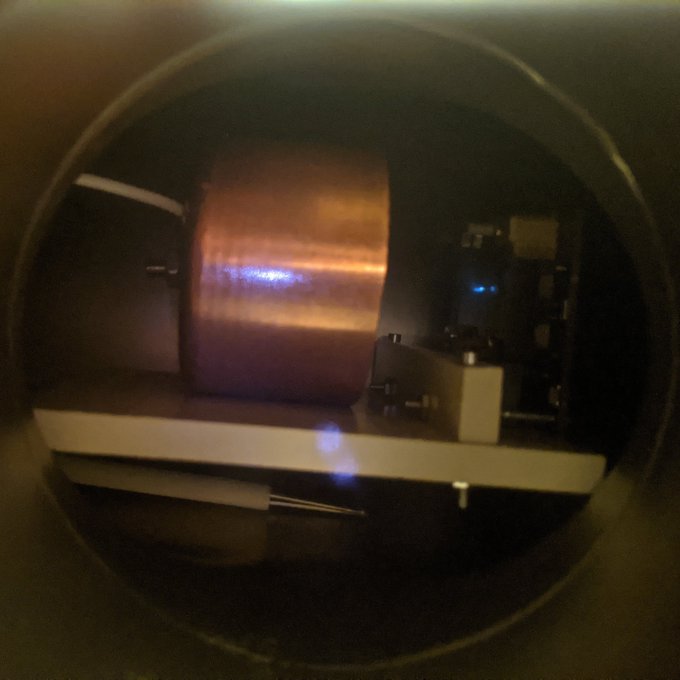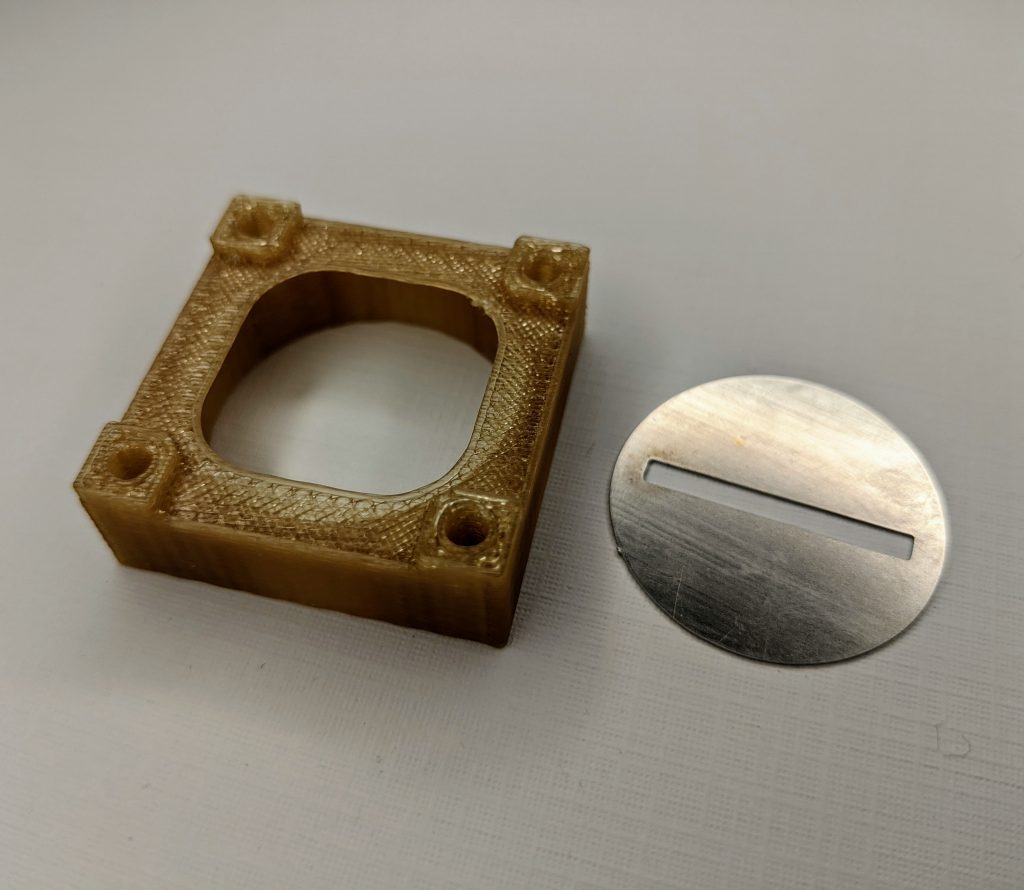Last night I ran the 7th ignition test of the ILIS1 electrospray thruster. It was a long battle with low emission, but finally, right at the end, I cranked the thruster up to 5.8kV, achieving 40uA of emission, giving me 3uN of thrust – the highest output yet by a factor of 10!
The major modifications for this test included adding a shield electrode to cover the exposed surface of the porous glass emitter disc to attempt to mitigate liquid creep between the disc surface and the extractor plate.
The next major change was implementing a slightly thicker extractor plate. Here we can see the V7 ILIS1 fully assembled, cleaned, and ready to go for testing!

Here we can see video of the thruster firing in its peak emission mode, delivering 40uA of beam current for an estimated thrust of about 3uN. At the end of the video, you can actually see shorting failure of the thruster.
The thruster operated very stably in this peak emission mode for several minutes before shorting failure occurs, which appears at the end of the video between the emitter and extractor. Here we can see a capture of the plume at max output, focused mainly on one area of the ridge.

For most of the duration of the test prior, emission again appeared to be more multisite and better spread across the extractor, which can be seen in this picture at very low beam outputs. However, emission is far too low here in this mode.

The thruster was operated in bipolar and monopolar modes. However, like prior testing, it was very apparent that the negative emission was severely reduced compared to the positive emission, and not as stable. This has implications going forward on my next development phase.
For peak operation at +5.8kV in monopolar mode, if we assume ideal PIR emission with 50/50 monomers/dimers, and a beam of just +EMI species, along with factoring 50% losses due to polydispersivity, this gives a rough estimated ISP of around 4500-4600s.
Although a short run with peak beam this test has many exciting breakthroughs. The biggest is thrust – 40uA emission is a major milestone, with 3uN of associated thrust from other key macro-ILIS thrusters in literature. This is far higher than prior tests and puts me on the board.
The next breakthrough is verifying that the shield electrode allowed me to operate at even higher output. Looking at the video, I don’t think failure was liquid creep, but rather liquid bridging, which shows the new design changes helped a ton mitigating the creep issue.
Finally the thruster operated at its highest voltages ever with no issue. The board was originally designed for only 3.5kV, but the unloaded Pico supplies can put out far more, and ran at this very high overvoltage without any issue. No electronics failures yet with the V6 PCB!
The single biggest takeaway from this test is that I am 100% positive now that my prior low emissions have been purely due to low field strengths. My emitter is just too blunt, and with a sharper emitter and more field gradient, I can actually achieve some serious thrust.
Moving forward, there are some key things to test. The big one is the emitter – I need a sharper emitter. While I sort out what to do for the next iteration, I will take one of my current ridge emitters and manually grind it to a spike and use a circular aperture extractor.
Next, due to changes of the negative emission, I will begin exploring using a conventional neutralizer and operating the thruster in positive monopolar mode. Since thrust/power is so high, I have a lot more room to work with a low-power neutralizer. I may be able to utilize a thermionic emitter at very low power and still keep within my power budget for a PQ thruster, employing multiple redundant filaments onboard. I will be therefore working on a new electronics package to accommodate this change and several new features. Interestingly, while ILIS is almost exclusively aimed at bipolar operation, apparently you can run in monopolar mode with a neutralizer. Just recently I found out that the new Busek BET-300-P is in fact a macro-ILIS multi-ridge thruster that operates monopolar with a neutralizer!
In addition to experimenting with neutralizers, I will also be looking at biased extractors. For bipolar operation, the extractor is grounded. However, in monopolar mode, I can actually bias this negative to achieve larger field gradient as well as play with output beam focusing. I thought this would be the last test for the ILIS1, however it looks like there is a ton of new stuff to explore! The next developments will include:
- new thruster board for monopolar mode, control, and neutralizer
- manually mod emitter to spikes
- negative biased extractor
This test has renewed my confidence in this development, bringing me much closer to my goal. I definitely think it is within reach now to achieve my target specs and eventually bring the AIS-ILIS series thrusters to life as low-cost electrospray for PQs and Cubesats!


